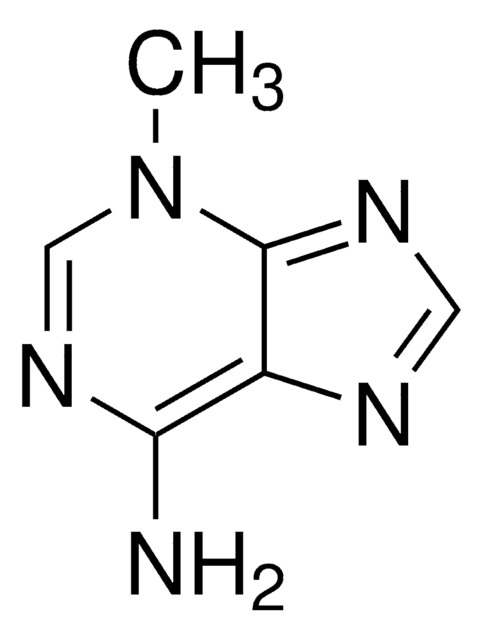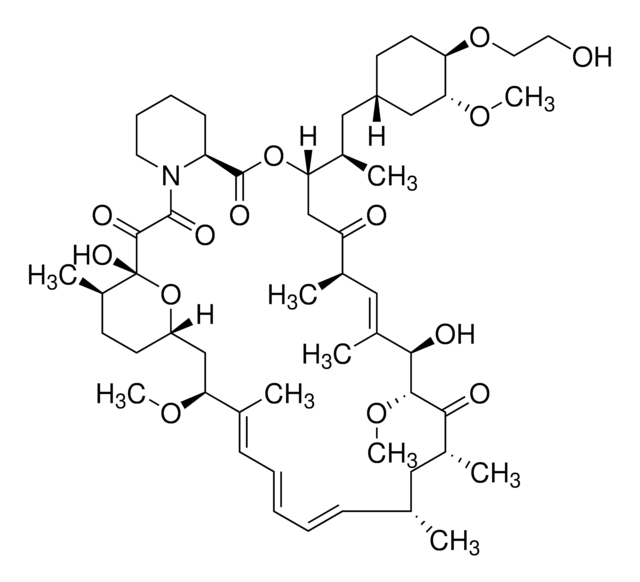553210
Rapamycin
≥95% (HPLC), powder
Sinônimo(s):
Rapamycin, mTOR Inhibitor I
About This Item
Produtos recomendados
Nível de qualidade
Ensaio
≥95% (HPLC)
Formulário
powder
fabricante/nome comercial
Calbiochem®
condição de armazenamento
OK to freeze
cor
clear
solubilidade
DMSO: 200 mg/mL
ethanol: 50 mg/mL
Condições de expedição
ambient
temperatura de armazenamento
−20°C
chave InChI
QFJCIRLUMZQUOT-UQKHEJQMSA-N
Descrição geral
Ações bioquímicas/fisiológicas
Mammalian target of rapamycin (mTOR)
Advertência
Reconstituição
Outras notas
Powell, D.J., et al. 2003. Mol. cell Biol.23, 7794.
Braun, W., et al. 1995. FASEB J.9, 63.
Nielsen, F.C., et al. 1995. Nature 377, 358.
Aagaard-Tillery, K.M. and Jelinek, D.F. 1994. Cell. Immunol. 156, 493.
Gottschalk, A.R., et al. 1994. Proc. Natl. Acad. Sci. USA91, 7350.
Morice, W.G., et al. 1993. J. Biol. Chem.268, 3734.
Terada, N., et al. 1993. J. Biol. Chem.268, 12062.
Kuo, J., et al. 1992. Nature 358, 70.
Price, D.J., et al. 1992. Science257, 973.
Heitman, J., et al. 1991. Science253, 905.
Kay, J.E., et al. 1991. Immunology72, 544.
Schreiber, S.L. 1991. Science251, 283.
Bierer, B.E., et al. 1990. Proc. Natl. Acad. Sci. USA87, 9231.
Dumont, F.J., et al. 1990. J. Immunol.144, 251.
Informações legais
Palavra indicadora
Warning
Frases de perigo
Declarações de precaução
Classificações de perigo
Carc. 2 - Repr. 2
Código de classe de armazenamento
11 - Combustible Solids
Classe de risco de água (WGK)
WGK 2
Certificados de análise (COA)
Busque Certificados de análise (COA) digitando o Número do Lote do produto. Os números de lote e remessa podem ser encontrados no rótulo de um produto após a palavra “Lot” ou “Batch”.
Já possui este produto?
Encontre a documentação dos produtos que você adquiriu recentemente na biblioteca de documentos.
Os clientes também visualizaram
Artigos
AldeRed™ 588-A is a red fluorescent live cell probe that detects ALDH activity used to identify cancer stem cells and progenitor cells in culture. Cancer stem cells (CSCs) are subpopulations of cancer cells that can self-renew, generate diverse cells in the tumor mass, and sustain tumorigenesis. Some researchers believe that cancer arises from cancer stem cells that originate as a result of mutational hits on normal stem cells.
Nossa equipe de cientistas tem experiência em todas as áreas de pesquisa, incluindo Life Sciences, ciência de materiais, síntese química, cromatografia, química analítica e muitas outras.
Entre em contato com a assistência técnica









